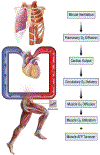The Oxygen Cascade During Exercise in Health and Disease
- PMID: 33714599
- PMCID: PMC8026750
- DOI: 10.1016/j.mayocp.2020.06.063
The Oxygen Cascade During Exercise in Health and Disease
Abstract
The oxygen transport cascade describes the physiological steps that bring atmospheric oxygen into the body where it is delivered and consumed by metabolically active tissue. As such, the oxygen cascade is fundamental to our understanding of exercise in health and disease. Our narrative review will highlight each step of the oxygen transport cascade from inspiration of atmospheric oxygen down to mitochondrial consumption in both healthy active males and females along with clinical conditions. We will focus on how different steps interact along with principles of homeostasis, physiological redundancies, and adaptation. In particular, we highlight some of the parallels between elite athletes and clinical conditions in terms of the oxygen cascade.
Copyright © 2020 Mayo Foundation for Medical Education and Research. Published by Elsevier Inc. All rights reserved.
Figures





References
-
- Rønnestad BR, Hansen J, Stensløkken L, Joyner MJ, Lundby C. Case Studies in Physiology: Temporal changes in determinants of aerobic performance in individual going from alpine skier to world junior champion time trial cyclist. J Appl Physiol. 2019;127(2):306–311. - PubMed
-
- Alexander NB, Dengel DR, Olson RJ, Krajewski KM. Oxygen-uptake (V̇O2) kinetics and functional mobility performance in impaired older adults. J Gerontol A Biol Sci Med Sci. 2003;58(8):M734–M739. - PubMed
Publication types
MeSH terms
Grants and funding
LinkOut - more resources
Full Text Sources
Other Literature Sources
Medical
Research Materials

